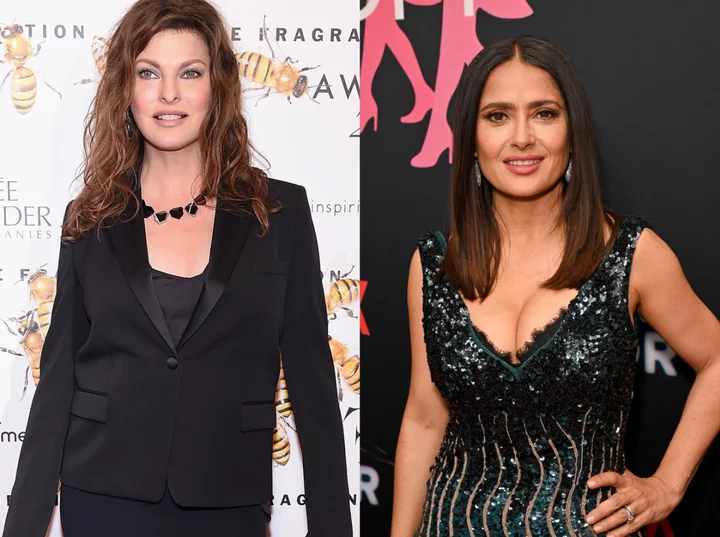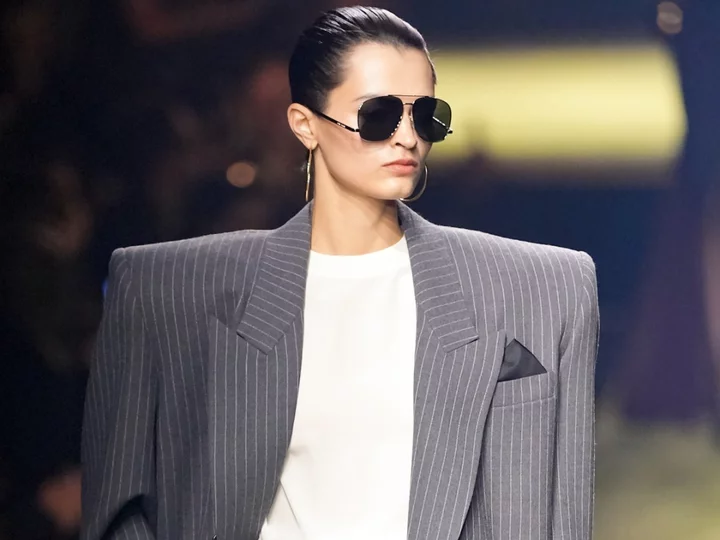
A cherished weekend flea market in the Ukrainian capital survives despite war
The Pochaina neighborhood in the Ukrainian capital comes alive every weekend as hundreds of people flock to its famous flea market, looking for finds
2023-08-12 14:28

13 Fascinating Facts About Grapes
Wine grapes and table grapes are a huge agricultural asset. It's no wonder that the humble grape is among the world's largest fruit crops.
2023-08-12 06:29

US-China Flights Approved to Double Under Government Agreement
Flights between the US and China are set to double from current levels by the end of October
2023-08-12 06:25

Linda Evangelista makes rare comment about co-parenting with son’s stepmother Salma Hayek
Linda Evangelista has made a rare comment about co-parenting with her son Augustin’s stepmother, Salma Hayek. The 58-year-old model spoke candidly about her relationship with her ex, François-Henri Pinault, and his wife, Hayek, during a recent interview with Vogue while appearing on the cover of the magazine’s September issue. She revealed that, during the holidays, her 16-year-old son is usually with his father and stepmother, who share a 15-year-old daughter, Valentina. However, according to Evangelista, there was one holiday celebration where she hadn’t felt well, so Hayek stepped in to take care of her. “I was sick at Thanksgiving,” she explained. “And Salma got on the plane with her daughter, came here, and made Thanksgiving dinner. She asked what I wanted - it was a very eclectic wish list.” She continued: “I wanted her Mexican chicken with truffled potatoes. And she spent the day in the kitchen and cooked it herself. No help. The kids helped her at the end.” She went on to praise Hayek for quickly coming to her aid immediately after she’d said that she was sick. “She made a feast - a beautiful, beautiful meal. I had told her that I wasn’t going to have Thanksgiving; I wasn’t feeling well. And she said: ‘Oh yes you are: I am coming.’ And poof, she was here,’” the model added. In 2011, Evangelista filed court papers to seek child support from Pinault, with the document revealing that he was the father of her son. While the pair had dated for three to four months in 2006, Pinault said that he’d only spent about seven days total with the model. They settled the child support case in 2012. It appears that Evangelista’s son and Hayek have gotten close over the years. In 2021, Hayek took to Instagram to share a rare snap of her and Augustin on a boat during what appeared to be a family vacation. Augustin also made his red carpet debut in April, alongside Hayek and Valentina, as they attended the Time 100 Gala together. Elsewhere in her interview with Vogue, Evangelista opened up about raising her son while in the spotlight. She recalled how, during the early days of her career, Madison Square Garden would call and offer her courtside seats to Knicks games, which she’d go to with her son. However, according to Evangelista, now that those calls have “stopped,” she and her son buy the tickets themselves. “Out of sight, out of mind. Now we buy our tickets and we sit with the fans in nosebleed - we’re fine with that. I wanted to have a very normal upbringing for my child,” she said. Evangelista also said that her son has questioned the benefits of fame, as he’s asked: “Do you think if they recognised you we would have to be standing in this line?” However, she said that she doesn’t hesitate to counter the question, before explaining that she doesn’t want her child to grow up being “entitled”. “What’s wrong with standing in this line? I stand in lines,” she said. “We went to Chanel a couple of weeks ago to get a present and we waited half an hour to get in. He said: ‘Isn’t there someone you could call?’ I do not want an entitled child.” Read More Salma Hayek admits fears over Black Mirror role: ‘Do I really want to do this? Am I going to get in trouble?’ Salma Hayek opens up about embracing her ‘whites hairs and wrinkles’ as she shares new selfie ‘I’m here anyway, why not?’: My non-surgical facelift has got me thinking about more procedures Katharine McPhee reveals she and David Foster suffered a ‘family tragedy’ Gemma Atkinson slams trolls who called her ‘fat’ just three weeks after giving birth Mother diagnosed with cystic fibrosis, anorexia and incurable cancer
2023-08-12 05:50

McDonald’s Removes ESG Abbreviation From Some Parts of Its Website
McDonald’s Corp. quietly removed the term “ESG” from some parts of its website at a time when environmental,
2023-08-12 03:49

Why Are St. Bernards Always Depicted With Barrels Around Their Necks?
The barrels we see around St. Bernards' necks in paintings and cartoons is the invention of an artist named Edwin Henry Landseer.
2023-08-12 02:54

Salzburg Festival nearly sold out while others in classical music struggle to regain audience
While many classical music institutions are struggling to regain audience, the Salzburg Festival in Mozart's hometown is on track to draw people from over 75 nations to opera, concerts and drama
2023-08-12 02:20

Amazon founder Jeff Bezos buys home in Miami's 'billionaire bunker.' Tom Brady will be his neighbor
The founder of Amazon is buying a home on an exclusive barrier island in Miami where he'll be neighbors with Tom Brady, Ivanka Trump and her husband, Jared Kushner
2023-08-12 01:23

Mountaineer denies ignoring dying porter on K2 record-breaking climb
A record-breaking Norwegian climber has hit out at what she calls "misinformation and hatred" surrounding claims she and her team climbed over a dying porter on K2 to summit the deadly peak.
2023-08-12 00:25

Air Canada Hedges Some of Its Fuel Bill for First Time in Years
Air Canada said it hedged about 30% of its jet fuel costs as it re-enters the oil derivatives
2023-08-12 00:18

Gemma Atkinson slams trolls who called her ‘fat and unfit’ just three weeks after giving birth
Gemma Atkinson has hit back at trolls who called her “fat and unfit” just three weeks after giving birth to her second child. The Hollyoaks actor, 38, who welcomed son Thiago with Strictly professional Gorka Marquez, revealed she had been branded “fat and lazy” by trolls after her mum pushed her son’s pram back from a doctor’s appointment. Gemma, who had a C-section with son Thiago only last month, said: “I didn’t want to overdo it. “I’ve had a message saying how lazy I was letting my mum push the pram. I got another saying ‘you used to be fit and you’re still fat’.”
2023-08-11 23:58

Menswear has made women feel confident for centuries, but will the gendered separation ever cease to exist?
I remember the day I realised the embodiment of my persona was a long-sleeve ironed shirt with only the collar close-lipped. Initially, I gravitated toward the crisp button-down for function, as my former workplace tended to emit heaps of chilly air, but a spontaneous feeling compelled me to button the top, leaving the rest of the shirt open. It may have been, in part, my obsession with wanting to define my look outside of popular construction or how this new silhouette framed my figure. Regardless, the androgynous piece of clothing left me feeling more confident than ever before. A clothing rack full of these formal tops sits perpendicular to my bed now, and I wear them strategically closed with almost every outfit. I couldn’t tell you exactly what it is about them that makes me feel alluring and powerful, but my style hasn’t been the same since. Now more than ever, women are setting aside archival forms of womenswear for the structure of men’s clothing, assuming their most confident, authentic selves. Mini denim shorts, bodycon dresses, and micro skirts are being swapped for baggy jorts and boxers. Individuals are donning contrasting proportions, taking risks, and exuding self-assurance in items that have historically been deemed representative of masculine codes in Western fashion. In doing so, women are diminishing the gap between gendered collections. According to Hazel Clark, professor of fashion studies at Parsons School of Design, women initiated the crossover between menswear and womenswear in the early 19th century when they started working in coal mines and riding horses. A working-class of women deliberately assumed the male dress code, whether business or activity related, because womenswear constricted their necessary movement with tight bodices and corded petticoats. Here, function and ability took precedent over society’s expectation of femininity as more opted to dirty a pair of trousers instead of their voluptuous gowns. Heading into the Second World War and the 20th century, the design gap minimised further when women’s roles in society advanced. In the 1940s, men were forced to leave their factory jobs for war, leaving their female counterparts to fill their positions. For women to be respected in the workplace, they mirrored the male look and wore the classic pantsuit. Francesca Granata, professor of fashion theory and history at Parsons, identified the “power suit of the 1980s” as “a classic instance of women trying to access men’s power in the workplace by wearing an outfit which imitated menswear and with wife shoulders: the ideal male physique.” She noted: “Yet the wide-shouldered suit jacket was often rendered appropriately feminine by being paired with a skirt.” With this came an influx of women wearing these masculine codes outside of the workplace. Though my grey dress pants from the men’s section of a closet sale were welcomed into my weekly rotation almost immediately, it took a lot of courage and self-assurance back then for women to wear similar pairs, just like it did for them to wear miniskirts when both styles were socially unacceptable. The initial need for “businesswear” transformed into desired style even if it meant a woman could be labeled as “inappropriate” or be refused at the door of an establishment. Looks from men turned to public disapproval, but that didn’t stop the progression of women dressing in menswear at all. “Although baggy clothing has been acceptable for men for quite some time, especially in the US, unlike older appropriation of menswear which were often adapted to be more skintight or revealing or somewhat rendered ‘feminine’ baggy clothes question the old dictum that women’s bodies should be on display for the male gaze,” Professor Granata remarked. In other words, this “sense of power dressing” left the confines of the office environment alongside any lingering thought to the heteronormative gaze. Fast forward to the early 21st century, when the groundwork for this fashion fusion had been laid in terms of utility and preference. As society began to understand sexuality and gender fluidity, non-gendered collections became increasingly popular. Designers became more proactive about creating androgynous clothing that didn’t need to be separated into the two typical identifiers: women and men. “Fashion must get to a point where we don’t have to talk about gender,” designer and creative director of Loewe Jonathan Anderson wrote in Amelia Anderson’s “What We Can Do Better” in 2021, nine years after he introduced the first transgender collection for his eponymous brand. “Fashion can be a way to experiment with character or to work out your identity, and I believe that clothes can have a protective role on a more emotional level.” Anderson’s obsession with how queer individuals dressed contributed to his perception that fashion can be used to “break the rules”. To him, clothing is a marker of individuality and subculture, which is what motivates him to create designs for people to express themselves free from outdated norms. Between boxy, textured T-shirts, bouncy blouses, and tailored high-waisted pants, Anderson’s worked to incorporate rival style cues even in his gender-specific collections. “Clothing is full of paradoxes, but ultimately it can empower us - and in a world that has historically taken power away from queer people, that can be vital,” he proclaimed. “In a world that often expects certain things for certain people when it comes to clothes - where society wants men, say, to wear some things, and women to wear others - I sometimes question why I do menswear and womenswear shows. But for me, it’s not about classifying people, it’s about using these categories as ideas - ideas to borrow from.” As designers helped bridge the gap, celebrities like Hailey Bieber and Bella Hadid have been seen being more experimental in campaigns for big name brands as well as in their personal street style. The 26-year-old Rhode Skin founder has been a recognised ambassador for the French fashion house, Yves-Saint Laurent, a company which has irrevocably impacted womenswear since their 1966 creation of a menswear-motivated tuxedo for women called “Le Smoking.” Both Bieber and Hadid blend feminine and masculine codes in everyday wear, leading the craze for oversized jean shorts and lengthy vintage sportswear paired with dainty ballet flats and platform boots. Other brands, such as Uniqlo and Thom Browne, design collections labelled and distributed as menswear and womenswear, but the items are still being bought and worn interchangeably. “It’s hard to explain,” Marissa Petteruti, senior menswear designer at Rag & Bone, tells The Independent when asked why she feels more assured in men’s clothing over feminine-labelled pieces. “I’ve always just felt more comfortable in, you know, oversized men’s shirts and pants. I kind of always have gravitated toward men’s fashion. I remember when I was a kid, my parents used to tell me: ‘You have to wear a skirt one day a week.’ I never saw why I couldn’t wear whatever I wanted. So maybe part of it became going against what my parents wanted me to do.” Petteruti has cultivated a closet full of suit pants, designer shirts, and vintage bomber jackets in pursuit of the perfect capsule wardrobe and collection of exclusive ready-to-wear. Ever since she attended the Parsons School of Design, pressure and expectation were absent from her style. Here, Petteruti was drawn to the serenity of menswear, and she appreciated the simplicity of its form more than women’s clothing. Her eyes wandered to streetwear brands such as Supreme and Hood-by-Air because the concept of a lux T-shirt intrigued her, and oversized pieces were pleasing. When she started at Rag & Bone, she learned that men’s tailoring was more extensive, but even so, the trends were ephemeral - meaning the pieces were inherently timeless. Womenswear detailing such as peplum cuts, scallop or lace trimming, floral embellishments, and sheer fabrics tend to cycle through seasonal collections more frequently than the stylistic choices and material preferences within menswear. The classic button-down may be presented in a specific range of colours depending on whether it’s fall or spring, but the shape and design stay the same. In other words, womenswear is more likely to follow suit with trends. Industry leaders and A-listers embracing a more avant-garde mindset in ready-to-wear and street style begs the question of whether brands will ever officially scrap the formal separation of womenswear and menswear. “Why do they have to be called ‘men’s clothing’? Just ‘cause you put the buttons on one side of the shirt and the fly on one side of the shirt and the reverse. It’s, it’s silly to me,” Petteruti agreed when asked if she thought the division was necessary. “I mean, the interesting thing about fashion now is at any given moment, it’s so diverse. We don’t all wear the same things to be in fashion. If we wanted to be in fashion, I mean, regardless of our sort of age or gender, you know, they’re like lots of different choices we can make, depending on the kind of the group we associate with or who we follow,” Clark explained. But Clark doesn’t believe concrete separation is on the horizon, due to the sizing and proportional differences between a man versus a woman. “Men’s and women’s bodies are different. You know, I mean, that’s part of it. Size and physique will prevent womenswear and menswear from being entirely infused with one another,” she proclaimed. Petteruti would argue that there’s potential. Already, she’s seen Rag & Bone mix more feminine codes into their menswear designs with varying fabrics and silhouettes. Being that inspiration is often plucked from the demand and visibility of others who motivate obsessions, the runway no longer dictates style fads. This means it may be expensive on the backend for companies, but we could see collections move away from the label if consumers want more androgynous, unisex pieces. As for Granata, she interprets the division of womenswear and menswear as already having been “tenuous,” which is exactly why women found themselves gravitating toward masculine codes to begin with. Read More How hip-hop went from being shunned by big business to multimillion-dollar collabs Dior celebrates 5 years as designer in gender-fluid Paris men's show Womenswear leads the way as Ted Baker sales soar
2023-08-11 23:58
